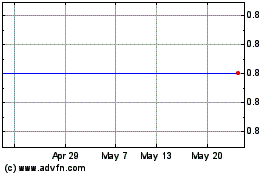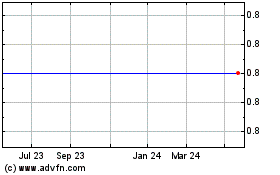TIDMSRES
RNS Number : 0273D
Sunrise Resources Plc
22 October 2015
22 October 2015
SUNRISE RESOURCES PLC
(the "Company")
BAY STATE SILVER PROJECT - PHASE 1 DRILL RESULTS
HIGH-GRADE SILVER INTERSECTIONS IN ALL DRILL HOLES
Sunrise Resources plc, the AIM-traded diversified mineral
exploration and development company, is pleased to announce
high-grade silver results from its first phase of drilling at the
Bay State Silver Project in Nevada.
Highlights
-- High-grade silver mineralisation encountered in all three drill holes, e.g.:
o 1,460 g/t silver (42.6 oz/ton) over 0.2m from 164.13m in Hole
15SRDD002
o 566 g/t silver (16.5 oz/ton) over 0.5m from 70.71m in Hole 15SRDD001
o 503 g/t silver (14.7 oz/ton) over 1.4m from 185.32m in Hole 15SRDD003
-- Chihuahua vein system encountered largely as predicted from 3D modelling.
-- High silver grades also intersected outside of known vein
system - indicating potential for additional discoveries.
-- Follow up drilling now warranted - drill permits already in
place to allow rapid progression of Phase 2 drilling.
Commenting today, Executive Chairman Patrick Cheetham said: "I
am pleased to be reporting success in hitting high grades of silver
mineralisation in all three drill holes in our first test of the
main Chihuahua Vein System. So far we have drilled at a wide
spacing on only the northern section of the vein, and to a
relatively shallow depth. We need to drill many more holes to get a
true picture of the silver mineralisation but this is an excellent
start."
Further information:
Sunrise Resources plc
Patrick Cheetham, Executive
Chairman Tel: +44 (0) 845 868 4590
Northland Capital Partners
Limited
Edward Hutton/David Hignell
John Howes/Mark Treharne
(Broking) Tel: +44 (0)20 7382 1100
Yellow Jersey PR Limited
Dominic Barretto Tel: +44 (0)7768 537739
Detailed Information
This announcement gives details of drilling results for three
diamond drill holes completed on behalf of the Company in late
August and early September of 2015 by drilling contractor Boart
Longyear.
The programme was designed to follow up high-grade and bonanza
silver sampling results from historical surface and underground
sampling, to provide valuable grade and geological information and
pave the way for more substantial programmes of drilling aimed at
resource definition.
Despite challenging drilling conditions, all three drill holes
were completed to at least their planned target depth for total
meterage of 600m.
All three drill holes were drilled from the west side of the
vein system. All core was logged in the field and sample intervals
marked up by the field geologist based on geological logging.
The mineralisation encountered in the drill holes is visually
distinctive and consistent with the vein-style mineralisation seen
in surface and underground exposures. The silver bearing vein zones
are characterised by silicification, spotty sulphide mineralisation
(galena and tetrahedrite) and staining with secondary copper
minerals. Analytical results indicate that contacts between high
grades and low grades of silver within the vein zone are sharp.
Samples of the drill core were taken in intervals not exceeding
5ft (1.53m). In most cases sampling was extended beyond the
visually mineralised intervals and a few speculative samples were
taken from other parts of the core showing different style of
alteration and mineralisation.
A total of 127 samples were taken for analysis. Significant
analytical results are shown in the attached table and details of
individual drill holes are as follows:
Hole SRDD001 was drilled at an angle of 70 degrees from
horizontal, perpendicular to the projected strike of the vein and
to a down-hole depth of 185m. It was designed to intersect the
Chihuahua vein below the floor of Mining Canyon and below the level
of the deepest mine working just south of the Chihuahua adit.
Two narrow but high-grade intervals of silver mineralisation
were encountered above the level of the predicted vein
intersection. Without further drilling it is not possible to say if
this represents a displaced or shallow dipping part of the main
vein.
The narrow high-grade silver mineralisation encountered at
88.70-88.85m down-hole was from a speculatively selected sample and
the high grade of this sample, 11.5 oz/ton silver (394 g/t), was
unexpected. No samples were taken either side of this interval and
further sampling around this interval is now required.
Hole SRDD002 was drilled high at the north-west end of Mining
Canyon at an angle of 45 degrees from horizontal, perpendicular to
the projected strike of the vein and to a down-hole depth of 183m.
It was successful in demonstrating the continuity of mineralisation
seen at the end of the Chihuahua adit and intersected the vein at
its projected depth.
In this hole the vein system has a total thickness of 13.4m and
contains narrow intervals of very high-grade mineralisation as
shown in the attached table.
Hole SRDD003 was drilled from the floor of Mining Canyon
approximately midway between the first two holes. It was drilled at
an angle of 45 degrees from horizontal, perpendicular to the
projected strike of the vein and to a down-hole depth of 232m.
The hole intersected a strong high-grade section of vein
material at the depth predicted from 3D modelling of the vein from
surface and underground workings and as shown in the attached
table.
Overall this first small drill programme has been successful in
demonstrating the continuity of silver mineralisation below and
beyond the level of historical workings over a tested strike length
of 320m.
To date only 3 of the 17 drill holes which have been permitted
to date have been completed and such limited drilling over a
significant strike length is unlikely to present an accurate
picture of a vein system that is likely to pinch and swell along
its length and where the higher grades and thicknesses are likely
to occur in defined ore shoots along the vein system. However the
results are considered to be highly encouraging and justify
additional drilling. Phase 2 drilling is now being planned.
A schematic diagram showing the location of drill holes and
drill intercepts, together with some core photographs, will shortly
be posted on the Bay State Silver Project page of the Company's
website.
Notes:
1. Reporting Units. The silver grade of samples is being
reported in the units grammes/tonne (g/t) or kg/tonne (kg/t) and
also in Troy ounces/short ton (oz/ton).
2. Drilling Method & Core Recovery. Drilling was completed
using a track mounted LF70 drill rig collecting HQ sized drill core
in a triple tube core barrel. Core recovery was high in both solid
rock and mineralised intervals. Where solid core was recovered it
was oriented with a down-hole Reflex core orientation tool to allow
for detailed structural analysis at a later date.
3. Analytical Methods & QA/QC. All drill core was submitted
to ALS Minerals in Reno, Nevada for sampling and analysis. All
samples selected for analysis were cut in half using a diamond saw
and half core was submitted for sample preparation and analysis.
The remaining half core was returned to the core box for storage
except in the case of a number of check samples where the half core
was cut again into two quarters with one quarter ("field
duplicate") being submitted for check analysis. All cut core
samples were crushed and pulverised and assayed for silver and base
metals using a four acid ore grade digest and ICP-AES analysis for
silver and base metals and other trace elements (ALS method
ME-ICP61a). Over-range silver values were determined using a
different four acid/analytical method (ALS method Ag-OG62). Samples
were also assayed for gold by 30g fire-assay (ALS Method Au-ICP21).
No significant gold values were returned consistent with previous
surface and underground sampling. ALS internal QA/QC data for the
analytical data was examined and found to be acceptable. Analytical
results for field duplicate samples show acceptable agreement.
3. True thicknesses. All thicknesses of mineralisation reported
in this announcement refer to the down-hole thicknesses of
mineralisation in the drill hole. The boundaries of the silver
mineralised zone are sometimes diffuse and fracture orientations
within the vein zone can vary. More detailed core logging is
required to optimise the structural information that can be taken
from the core and this structural information will add to knowledge
of the variation of vein orientations in future. In Holes SRDD002
and 003 the vein zones were intersected largely in the positions
expected based on projecting the veins from the underground
workings at an 85 degrees dip towards these drill holes and on this
basis true thicknesses are estimated for these two holes at 80% of
intersected thicknesses. The mineralised intersections in hole
SRDD001 cannot be estimated without further core logging and
evaluation and drilling.
4. The information in this release has been compiled and
reviewed by Mr. Patrick Cheetham (MIMMM, MAusIMM) who is a
qualified person for the purposes of the AIM Note for Mining and
Oil & Gas Companies. Mr Cheetham is a Member of the Institute
of Materials, Minerals & Mining and also a member of the
Australasian Institute of Mining & Metallurgy.
Table of Significant Assay Results from 1(st) Round Sampling,
Phase 1 drilling.
(MORE TO FOLLOW) Dow Jones Newswires
October 22, 2015 02:00 ET (06:00 GMT)
Sunrise Diamonds (LSE:SDS)
Historical Stock Chart
From Mar 2024 to Apr 2024

Sunrise Diamonds (LSE:SDS)
Historical Stock Chart
From Apr 2023 to Apr 2024
